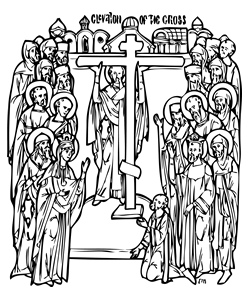|
|||
|---|---|---|---|
| This weekly bulletin insert complements the curriculum published by the Department of Christian Education of the Orthodox Church in America. This and many other Christian Education resources are available at http://dce.oca.org. | |||

September 14th is the Feast of the Exaltation (or Elevation) of the Precious and Life-Giving Cross. There are two events in history to which this feast takes us, as Eugen J. Pentiuc writes in his book "The Old Testament in Eastern Orthodox Tradition" (Oxford University Press 2014). The first took place in the year 335, when the church built by Constantine over the traditional site of Christ's tomb was consecrated in Jerusalem. It was named the Church of the Resurrection; it is now known as the Church of the Holy Sepulchre. The second event occurred in 629, fifteen years after the Persians had sacked and looted the church, taking as part of their spoils a relic of the True Cross. In 629 the Byzantine emperor Heraclius was able to recover the relic, and to bring it to Constantinople. There he carried it into the great church of Hagia Sophia, and elevated it as a sign of victory. Father Pentiuc notes that one of the readings for the Great Vespers of the feast is Exodus 15: 22-16: 1. This is the account of Moses leading the people of Israel on from the Red Sea, after the exodus from Egypt, into the wilderness of Shur. They come, thirsty and tired, to the waters of Marah, only to find that the water is too bitter to drink. As so often, the people complain and "murmur against" poor Moses. He, in turn, cries out to God. The Lord shows him a tree, which he flings into the water. At once the water becomes sweet enough to drink. Soon the people come to Elim where they encamp under seventy palm trees, surrounded by twelve springs and buoyed by God's promise that if they will keep His statutes, He will spare them the diseases He has used to chastise the arrogant, heedless Egyptians. Reading this passage reminds us that the Old Testament often prepares us for what happened to Jesus Christ. The tree at Marah is like the wood of the Cross, which sweetens everything bitter because it gives us eternal life. The crucified Christ rises from the dead, "upon those in the tomb bestowing life." One of the stikhera for the festal Great Vespers speaks about another tree: "Come, all you nations, let us worship the blessed Tree through which was wrought the everlasting righteousness. For he who by a tree beguiled our forefather Adam is himself ensnared by the Cross." Here the blessed Tree is the cross, but the tree with which Satan beguiled Adam is the tree in the Garden.
Saint John Chrysostom also makes reference to Satan, as the one who conquered Adam by tempting him to eat of the forbidden tree in Paradise. But the conqueror is conquered by the Resurrection, which robs Satan of his fatal power over humankind. The tree in the Garden, the tree at Marah, and in fact the whole Old Testament, lead us to the Tree by which Jesus Christ will conquer death once and for all. |
|||
